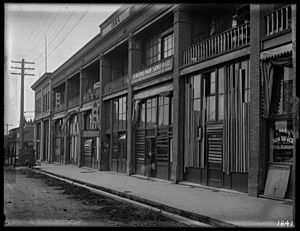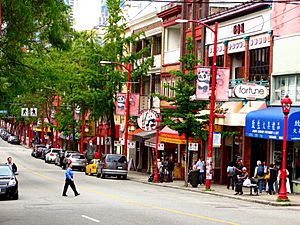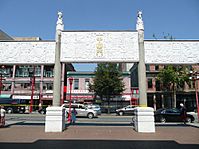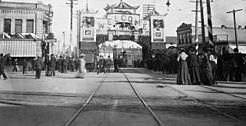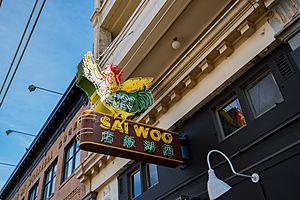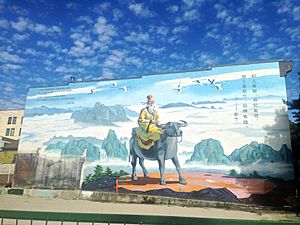Chinatown, Vancouver facts for kids
Quick facts for kids
Chinatown
|
|
|---|---|
|
Neighbourhood
|
|
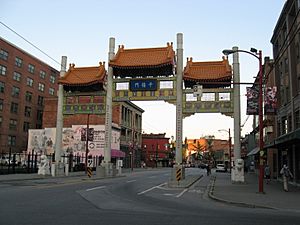
Millennium Gate on Pender Street in Chinatown
|
|
| Country | |
| Province | |
| City | |
| Time zone | UTC−8 (Pacific) |
| • Summer (DST) | UTC−7 (PDT) |
| Area Codes | 604, 778, 236 |
| Chinatown, Vancouver | |||||||||||||
|---|---|---|---|---|---|---|---|---|---|---|---|---|---|
| Traditional Chinese | 溫哥華唐人街 | ||||||||||||
| Simplified Chinese | 温哥华唐人街 | ||||||||||||
|
|||||||||||||
| Alternative Chinese name | |||||||||||||
| Traditional Chinese | 溫哥華華埠 | ||||||||||||
| Simplified Chinese | 温哥华华埠 | ||||||||||||
|
|||||||||||||
|
Designations
|
|
| Official name: Vancouver's Chinatown National Historic Site of Canada | |
| Designated: | 2011 |
|---|---|
Chinatown in Vancouver, British Columbia, is the largest Chinatown in Canada. It is located around Pender Street. This area is surrounded by Gastown and the city's main business districts. It is also near the old Japantown and the Strathcona neighbourhood.
Chinatown is a popular place for tourists to visit. It is one of the biggest historic Chinatowns in North America. However, it has changed over time as many Chinese families moved to other parts of Vancouver.
Vancouver has a large number of people with Chinese heritage. Many are Chinese Canadians who have lived here for generations. Others are new immigrants, especially from Hong Kong and Mainland China. Because of this, Vancouver has sometimes been called "Hongcouver."
Contents
Exploring Chinatown's Location
The City of Vancouver has set official boundaries for Chinatown. These are the alley between Pender and Hastings Streets, Georgia Street, Gore Avenue, and Taylor Street. However, many people feel the area extends further into the Downtown Eastside. The main streets for shopping and businesses are Main, Pender, and Keefer Streets.
The Golden Village: A New Chinese Hub
In recent years, a new business area for Chinese immigrants has grown. This area is along No. 3 Road in Richmond, south of Vancouver. Many wealthy immigrants from Hong Kong and Taiwan moved there starting in the late 1980s. This led to more Chinese shops and restaurants in Richmond.
The City of Richmond calls this new area the "Golden Village." There was a plan to rename it "Chinatown," but this idea faced opposition. Both merchants in Vancouver's Chinatown and non-Chinese residents in Richmond did not agree with the name change.
Chinatown's Rich History
Early Arrivals and the Head Tax

Chinese immigrants first came to Vancouver in large numbers in the late 1800s. They were drawn by the gold rush of 1858 and the building of the Canadian Pacific Railway in the 1880s. By 1884, about 17,000 Chinese immigrants had arrived in Canada just to work on the railway.
After the railway was finished, the Canadian government introduced a special tax. This was called the head tax. It was a fee of $50 that only Chinese immigrants had to pay to enter Canada. The government wanted to discourage more Chinese people from settling in the country. This tax was later raised to $100 in 1900 and then to $500 in 1903.
By 1900, Chinatown covered four city blocks. Pender Street was the main shopping area. At this time, some city officials had negative views about the living conditions in Chinatown. This led to unfair treatment and violence against the Chinese community.
Clan Societies and the 1907 Riot
As more Chinese people came to Vancouver, they formed groups called clan societies. These groups helped new immigrants settle into their new home. They offered friendship and support. These societies were often based on shared family names or hometowns.
Despite these efforts, unfair treatment against Chinese residents grew. This eventually led to violence. In September 1907, the Vancouver riots broke out. They started after a rally against immigration. These riots caused a lot of damage to businesses in Chinatown. About 2,000 Chinese immigrants lost their homes. The total damage to property was around $15,000.
After the riot, Mackenzie King, who was a government official, investigated the event. He recommended that the government pay $36,000 to help those who suffered losses. The head tax was finally removed in 1923. However, a new law, the Chinese Immigration Act of 1923, then stopped almost all Chinese immigration to Canada.
Improvements in the Late 20th Century
In 1979, a committee worked to improve Chinatown's streets. They added Chinese-style features like special sidewalks and red dragon streetlamps. These changes helped show the area as a special place for cultural tourism. In 1971, the province officially recognized Chinatown as a historic area. Since then, Chinatown has become more of a cultural centre than just a business district.
A local non-profit group called Murality is painting a mural on East Pender Street. This aims to add colour and life to the neighbourhood. Over the 20th century, Chinatown grew into a strong community. However, many Chinese immigrants eventually moved away. This caused some local businesses to struggle.
The Chinatown Merchants Association pointed out problems like a lack of parking. They also mentioned strict rules for the historic district. These rules made it hard for new businesses or renovations. Because of these concerns, the rules were made more flexible. This allowed for more types of businesses and some older buildings to be taken down if needed.
In the mid-1990s, new additions included a large parking garage and a shopping mall. Canada's largest Chinese restaurant also opened there. More homes were built, and property taxes were lowered. These changes helped keep the community strong. The idea of "reinvigoration" was important to government members. The Millennium Gate project, opened in 2002, was a symbol of this renewal. The early Chinese settlers in Vancouver's Chinatown helped make Vancouver known around the world. It became a popular place for Asian investment and immigration.
Recent Immigration Trends
Besides Chinese people from Taiwan, Hong Kong, and Mainland China, some Chinese Latin Americans have also moved to Chinatown. Many came from Peru after a military coup in 1968. Others arrived from countries like Argentina, Brazil, Mexico, and Nicaragua.
Vancouver saw many immigrants from the Asia-Pacific region in the late 1900s. The Chinese population in the Vancouver area was about 300,000 in the mid-1990s. Since the 1980s, Chinese people have become more connected across different countries. It became easier for money, information, and people to move across borders. This changed the traditional idea of migration.
More Chinese immigrants have settled in Richmond compared to Chinatown itself. This is because Richmond has lower house prices and many Chinese shops. It is also close to the Vancouver airport. Chinatown's businesses were affected when new Asian shopping areas opened in the suburbs. For example, Richmond's Aberdeen Centre was promoted as North America's largest Asian mall. It offered more parking and open space than historic Chinatown.
Chinatown's Unique Architecture
Chinatown was named a National Historic Site of Canada in 2011. This means it is a very important place in Canadian history.
Efforts are ongoing to make the area even better. Businesses are working to improve safety by hiring private security. They are also looking into new ways to promote the area. Another goal is to add more homes by fixing up old, historic buildings. The current focus is on restoring and finding new uses for the special buildings in the area.
Famous Buildings in Chinatown
- Sam Kee Building (8 West Pender Street): Built in 1913, this is known as the narrowest commercial building in the world. It is only about 6 feet deep!
- Wing Sang Building (51 East Pender Street): Built between 1889 and 1901, it is one of Chinatown's oldest buildings. It was home to Yip Sang's Wing Sang Company.
- Chinese Freemasons Building (1–5 West Pender Street): The front of this building was kept even after the rest was taken down in 1975.
- Chinese Benevolent Association of Vancouver (104–108 East Pender Street): This building was built between 1901 and 1910. The Association helped Chinese immigrants.
- Dr. Sun Yat-Sen Classical Chinese Garden (578 Carrall St): Opened in 1986, this is a beautiful traditional Chinese garden.
- Chinese Times Building (1 East Pender Street): Built in 1902, this was one of the first brick buildings in Chinatown. It influenced how other buildings were designed.
- Carnegie Community Centre (401 Main Street): Built in 1902–03, this building was once a Carnegie library.
- Kuomintang Building (296 East Pender Street): This building was built in 1920 for the Kuomintang, a Chinese political party.
- Ho Ho Restaurant and Sun Ah Hotel (100–102 East Pender Street): The Ho Ho Restaurant opened here in 1954.
Chinatown's Gates
The China Gate is next to the Chinese Cultural Centre on Pender Street. The government of the People's Republic of China gave it to Vancouver after the Expo 86 world's fair. It was rebuilt and updated in 2005 with stone and steel.
This gate is different from the larger Millennium Gate. The Millennium Gate crosses over Pender Street at the west end of Chinatown. It was built in 2002. It stands where a temporary wooden arch once welcomed the Duke and Duchess of Cornwall and York in 1901.
Other Important Buildings
The Lord Strathcona Elementary School is the oldest public school in Greater Vancouver. It is the only public school that serves Vancouver's Chinatown.
Neon Signs: A Bright History
Chinatown used to be famous for its many bright neon signs. However, a city rule in 1974 caused many signs to be taken down. The last of these, the Ho Ho sign (which showed a rice bowl and chopsticks), was removed in 1997.
In 2010, a new, tall neon sign was put up for the Chinatown Plaza parking garage. In 2017, a new neon sign with a large green and yellow rooster was installed for the Sai Woo Restaurant. This sign was rebuilt based on an old video clip from 1958. There are also plans to relight the old Ho Ho sign.
The Laozi Mural
Vancouver's Laozi mural is on the side of the Lee's Association building. This is at the corner of Gore Avenue and Pender Street, at the edge of Chinatown. The mural was officially revealed on October 2, 2010. This was part of the celebration for Vancouver Chinatown's 125th anniversary. The mural is considered one of Vancouver's notable murals.
Kenson Seto designed the mural, and Alex Li & Falk painted it. It is 223 square metres in size. The cost was $18,000, shared by the City of Vancouver and Lee's Association. Sadly, the mural was damaged by graffiti several times.
In 2016, the City of Vancouver approved a plan to build a six-story building. This new building will hide the mural from view. The city council added a condition for the new building. They asked the developer to create a new mural that reflects Chinatown's history. The developer is thinking about painting a smaller version of the original mural on the new building.
Images for kids


